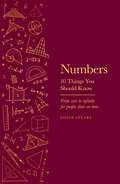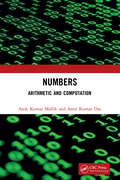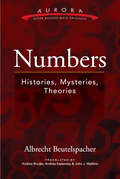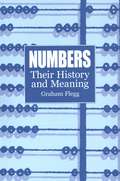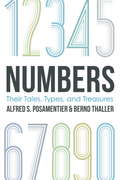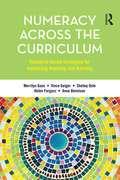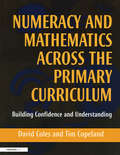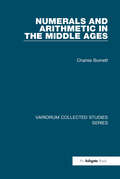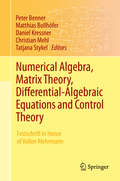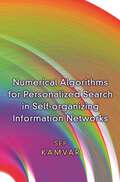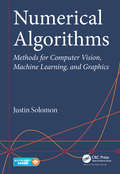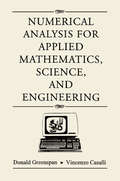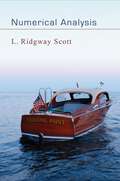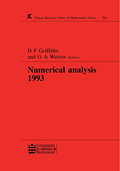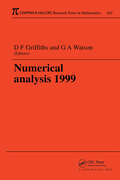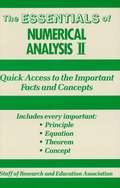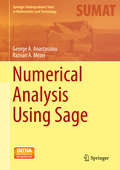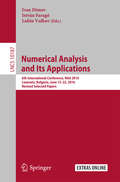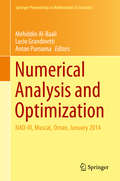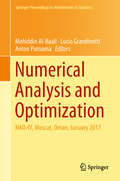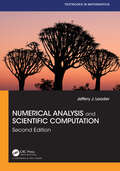- Table View
- List View
Numbers at Work: A Cultural Perspective
by Rudolf TaschnerDrawing primarily from historical examples, this book explains the tremendous role that numbers and, in particular, mathematics play in all aspects of our civilization and culture. The lively style and illustrative examples will engage the reader who wants to understand the many ways in which mathematics enables science, technology, art, music, pol
Numbers: 10 Things You Should Know
by Colin StuartUncover the language of our universe - numbers - in this wide-ranging whistle-stop tour of the history and majesty of mathematics.Our world simply wouldn't function if we didn't have numbers. But where do they come from? Why do we cut cake the wrong way? How can there be different sizes of infinity?All these questions and more are answered in this engaging romp through the history of numbers by acclaimed science writer, Colin Stuart. From the mathematicians who have (and haven't) shouted 'Eureka!' to the theories that affect and inform our everyday lives; Numbers shows us that maths was never boring - we were just being taught it in the wrong way.Consisting of ten bite-sized essays, there's no better guide to this fundamental science.
Numbers: 10 Things You Should Know
by Colin StuartUncover the language of our universe - numbers - in this wide-ranging whistle-stop tour of the history and majesty of mathematics.Our world simply wouldn't function if we didn't have numbers. But where do they come from? Why do we cut cake the wrong way? How can there be different sizes of infinity?All these questions and more are answered in this engaging romp through the history of numbers by acclaimed science writer, Colin Stuart. From the mathematicians who have (and haven't) shouted 'Eureka!' to the theories that affect and inform our everyday lives; Numbers shows us that maths was never boring - we were just being taught it in the wrong way.Consisting of ten bite-sized essays, there's no better guide to this fundamental science.
Numbers: Arithmetic and Computation
by Asok Kumar Mallik Amit Kumar DasThis book contains a number of elementary ideas on numbers, their representations, interesting arithmetical problems and their analytical solutions, fundamentals of computers and programming plus programming solutions as an alternative to the analytical solutions and much more.Spanning seven chapters, this book, while keeping its lucid storytelling verve, describes integers, real numbers and numerous interesting properties and historical references; followed by a good collection of arithmetic problems and their analytical solutions. Please note: Taylor & Francis does not sell or distribute the Hardback in India, Pakistan, Nepal, Bhutan, Bangladesh and Sri Lanka.
Numbers: Histories, Mysteries, Theories (Aurora: Dover Modern Math Originals)
by John J. Watkins Albrecht Beutelspacher Andrea Bruder Andrea EasterdayPosing the question "What exactly is a number?" a distinguished German mathematician presents this intriguing and accessible survey. Albrecht Beutelspacher ― founder of the renowned interactive mathematics museum, Mathematikum ― characterizes the wealth of experiences that numbers have to offer. In addition, he considers the many things that can be described by numbers and discusses which numbers possess special fascinations and pose lasting mysteries. Starting with natural numbers, the book examines representations of numbers, rational and irrational numbers, transcendental numbers, and imaginary and complex numbers. Readers will explore the history of numbers from Pythagoras to Fermat and discover such practical applications as cryptography and barcodes. A thoughtful and enlightening introduction to the past, present, and future of numbers, this volume will captivate mathematicians and nonmathematicians alike.
Numbers: Their History and Meaning
by Graham FleggExtremely readable, jargon-free book for general readers traces the evolution of counting systems, from the primitive techniques of antiquity to computers. Text examines the earliest endeavors to count and record numbers, initial attempts to solve problems by using equations, and origins of infinite cardinal arithmetic. "Surprisingly exciting." -- Choice.
Numbers: Their Tales, Types, and Treasures
by Alfred S. Posamentier Bernd ThallerDid you grow up thinking math is boring? It's time to reconsider. This book will teach you everything you ever wondered about numbers--and more.How and why did human beings first start using numbers at the dawn of history? Would numbers exist if we Homo sapiens weren't around to discover them? What's so special about weird numbers like pi and the Fibonacci sequence? What about rational, irrational, real, and imaginary numbers? Why do we need them?Two veteran math educators explain it all in ways even the most math phobic will find appealing and understandable. You'll never look at those squiggles on your calculator the same again.From the Trade Paperback edition.
Numeracy Across the Curriculum: Research-based strategies for enhancing teaching and learning
by Shelley Dole Merrilyn Goos Anne Bennison Helen Forgasz Vince GeigerBeing numerate involves more than mastering basic mathematics. Numeracy connects the mathematics learned at school with out-of-school situations that require capabilities such as problem solving, critical judgment, and sense-making related to non-mathematical contexts. This book provides prospective and practising teachers with practical, research-based strategies for embedding numeracy across the primary and secondary school curriculum. Based on the authors' ten-year research program, the text explains what numeracy is and how numeracy has developed as an educational goal. It describes in detail the five dimensions of the authors' model: attention to real-life contexts; application of mathematical knowledge; use of physical, representational and digital tools; the promotion of positive dispositions towards the use of mathematics to solve problems encountered in day-to-day life; and a critical orientation to interpreting mathematical results and making evidence-based judgements. There is guidance on how to embed numeracy across all subjects within the curriculum, how to assess numeracy learning and how to deal with challenges and dilemmas including working with discipline boundaries and developing support resources.Featuring practical examples and case studies throughout, this book will build pre-service teacher confidence, demystify common misconceptions and grounds theory into practice in this vital area of student competency.'The authors of this text are recognised authorities on numeracy. They have engaged heavily in numeracy research over many years and this text reflects the depth of their understanding and knowledge.' - Geoff Hilton, University of Queensland
Numeracy and Mathematics Across the Primary Curriculum: Building Confidence and Understanding
by David Coles Tim CopelandThe key to good primary teaching of numeracy and mathematics is confidence in mathematical knowledge and its relevance to the real world. In particular, effective implementation of the National Numeracy Strategy requires student teachers, primary teachers and mathematics coordinators to realize the place of mathematics across the range of National Curriculum subjects. This book explores mathematics as a set of tools for thinking about, designing, evaluating and changing the world of the child through the broader curriculum, rather than focusing on skills and concept building exclusively in the 'mathematical world.' Practical activities are included to stimulate readers to apply these ideas with confidence both within and beyond the mathematics lesson.
Numeracy for Childcare Students: A Basic Skills Guide
by June GreenFirst Published in 2004. Routledge is an imprint of Taylor & Francis, an informa company.
Numerals and Arithmetic in the Middle Ages (Variorum Collected Studies)
by Charles BurnettThis volume, the third by Charles Burnett in the Variorum series, brings together articles on the different numeral forms used in the Middle Ages, and their use in mathematical and other contexts. Some pieces study the introduction of Hindu-Arabic numerals into Western Europe, documenting, in more detail than anywhere else, the different forms in which they are found, before they acquired the standard shapes with which we are familiar today. Others deal with experiments with other forms of numeration within Latin script: e.g., using the first nine Roman numerals as symbols with place value, abbreviating the Roman numerals, and using the Latin letters as numerals. The author discusses how different types of numerals are used for different purposes, and the application of numerals to the abacus, and to calculation with pen and ink. The studies include the critical edition of several Latin texts.
Numerical Algebra, Matrix Theory, Differential-Algebraic Equations and Control Theory
by Peter Benner Matthias Bollhöfer Daniel Kressner Christian Mehl Tatjana StykelThis edited volume highlights the scientific contributions of Volker Mehrmann, a leading expert in the area of numerical (linear) algebra, matrix theory, differential-algebraic equations and control theory. These mathematical research areas are strongly related and often occur in the same real-world applications. The main areas where such applications emerge are computational engineering and sciences, but increasingly also social sciences and economics. This book also reflects some of Volker Mehrmann's major career stages. Starting out working in the areas of numerical linear algebra (his first full professorship at TU Chemnitz was in "Numerical Algebra," hence the title of the book) and matrix theory, Volker Mehrmann has made significant contributions to these areas ever since. The highlights of these are discussed in Parts I and II of the present book. Often the development of new algorithms in numerical linear algebra is motivated by problems in system and control theory. These and his later major work on differential-algebraic equations, to which he together with Peter Kunkel made many groundbreaking contributions, are the topic of the chapters in Part III. Besides providing a scientific discussion of Volker Mehrmann's work and its impact on the development of several areas of applied mathematics, the individual chapters stand on their own as reference works for selected topics in the fields of numerical (linear) algebra, matrix theory, differential-algebraic equations and control theory. "
Numerical Algorithms for Personalized Search in Self-organizing Information Networks
by Sep KamvarThis book lays out the theoretical groundwork for personalized search and reputation management, both on the Web and in peer-to-peer and social networks. Representing much of the foundational research in this field, the book develops scalable algorithms that exploit the graphlike properties underlying personalized search and reputation management, and delves into realistic scenarios regarding Web-scale data.Sep Kamvar focuses on eigenvector-based techniques in Web search, introducing a personalized variant of Google's PageRank algorithm, and he outlines algorithms--such as the now-famous quadratic extrapolation technique--that speed up computation, making personalized PageRank feasible. Kamvar suggests that Power Method-related techniques ultimately should be the basis for improving the PageRank algorithm, and he presents algorithms that exploit the convergence behavior of individual components of the PageRank vector. Kamvar then extends the ideas of reputation management and personalized search to distributed networks like peer-to-peer and social networks. He highlights locality and computational considerations related to the structure of the network, and considers such unique issues as malicious peers. He describes the EigenTrust algorithm and applies various PageRank concepts to P2P settings. Discussion chapters summarizing results conclude the book's two main sections.Clear and thorough, this book provides an authoritative look at central innovations in search for all of those interested in the subject.
Numerical Algorithms: Methods for Computer Vision, Machine Learning, and Graphics
by Justin SolomonNumerical Algorithms: Methods for Computer Vision, Machine Learning, and Graphics presents a new approach to numerical analysis for modern computer scientists. Using examples from a broad base of computational tasks, including data processing, computational photography, and animation, the textbook introduces numerical modeling and algorithmic desig
Numerical Analysis
by Donald GreenspanFirst Published in 2018. Routledge is an imprint of Taylor & Francis, an Informa company.
Numerical Analysis
by Larkin Ridgway ScottComputational science is fundamentally changing how technological questions are addressed. The design of aircraft, automobiles, and even racing sailboats is now done by computational simulation. The mathematical foundation of this new approach is numerical analysis, which studies algorithms for computing expressions defined with real numbers. Emphasizing the theory behind the computation, this book provides a rigorous and self-contained introduction to numerical analysis and presents the advanced mathematics that underpin industrial software, including complete details that are missing from most textbooks. Using an inquiry-based learning approach, Numerical Analysis is written in a narrative style, provides historical background, and includes many of the proofs and technical details in exercises. Students will be able to go beyond an elementary understanding of numerical simulation and develop deep insights into the foundations of the subject. They will no longer have to accept the mathematical gaps that exist in current textbooks. For example, both necessary and sufficient conditions for convergence of basic iterative methods are covered, and proofs are given in full generality, not just based on special cases. The book is accessible to undergraduate mathematics majors as well as computational scientists wanting to learn the foundations of the subject. Presents the mathematical foundations of numerical analysis Explains the mathematical details behind simulation software Introduces many advanced concepts in modern analysis Self-contained and mathematically rigorous Contains problems and solutions in each chapter Excellent follow-up course to Principles of Mathematical Analysis by Rudin
Numerical Analysis 1993
by D.F. Griffiths G.A. WatsonThis volume contains invited papers presented at the 15th Dundee Biennial Conference on Numerical Analysis held at the University of Dundee in June of 1993. The Dundee Conferences are important events in the numerical analysis calendar, and the papers published here represent accounts of recent research work by leading numerical analysts covering a wide range of fields of interest. The book is a valuable guide to the direction of current research in many areas of numerical analysis. It will be of particular interest to graduate students and research workers concerned with the theory and application of numerical methods for solving ordinary and partial differential equations.
Numerical Analysis 1999 (Chapman & Hall/CRC Research Notes in Mathematics Series)
by Df Griffiths Ga WatsonOf considerable importance to numerical analysts, this text contains the proceedings of the 18th Dundee Biennial Conference on Numerical Analysis, featuring eminent analysts and current topics. The papers cover everything from partial differential equations to linear algebra and approximation theory and contain contributions from the leading expert
Numerical Analysis II Essentials
by The Editors of REAREA's Essentials provide quick and easy access to critical information in a variety of different fields, ranging from the most basic to the most advanced. As its name implies, these concise, comprehensive study guides summarize the essentials of the field covered. Essentials are helpful when preparing for exams, doing homework and will remain a lasting reference source for students, teachers, and professionals. Numerical Analysis II covers simultaneous linear systems and matrix methods, differential equations, Fourier transformations, partial differential equations, and Monte Carlo methods.
Numerical Analysis Using R
by Graham W. GriffithsThis book presents the latest numerical solutions to initial value problems and boundary value problems described by ODEs and PDEs. The author offers practical methods that can be adapted to solve wide ranges of problems and illustrates them in the increasingly popular open source computer language R, allowing integration with more statistically based methods. The book begins with standard techniques, followed by an overview of 'high resolution' flux limiters and WENO to solve problems with solutions exhibiting high gradient phenomena. Meshless methods using radial basis functions are then discussed in the context of scattered data interpolation and the solution of PDEs on irregular grids. Three detailed case studies demonstrate how numerical methods can be used to tackle very different complex problems. With its focus on practical solutions to real-world problems, this book will be useful to students and practitioners in all areas of science and engineering, especially those using R.
Numerical Analysis Using Sage
by George A. Anastassiou Razvan A. MezeiThis is the first numerical analysis text to use Sage for the implementation of algorithms and can be used in a one-semester course for undergraduates in mathematics, math education, computer science/information technology, engineering, and physical sciences. The primary aim of this text is to simplify understanding of the theories and ideas from a numerical analysis/numerical methods course via a modern programming language like Sage. Aside from the presentation of fundamental theoretical notions of numerical analysis throughout the text, each chapter concludes with several exercises that are oriented to real-world application. Answers may be verified using Sage. The presented code, written in core components of Sage, are backward compatible, i. e. , easily applicable to other software systems such as Mathematica®. Sage is open source software and uses Python-like syntax. Previous Python programming experience is not a requirement for the reader, though familiarity with any programming language is a plus. Moreover, the code can be written using any web browser and is therefore useful with Laptops, Tablets, iPhones, Smartphones, etc. All Sage code that is presented in the text is openly available on SpringerLink. com.
Numerical Analysis and Its Applications
by Ivan Dimov István Faragó Lubin VulkovThis volume of the Lecture Notes in Computer Science series contains the p- ceedings of the 3rd Conference on Numerical Analysis and Its Applications, which was held at the University of Rousse, Bulgaria, June 29-July 3, 2004. The conference was organized by the Department of Numerical Analysis and Statistics at the University of Rousse with the support of the Department of Mathematics of North Carolina State University. This conference continued the tradition of the two previous meetings (1996, 2000 in Rousse) as a forum where scientists from leading research groups from the "East" and "West" are provided with the opportunity to meet and exchange ideasandestablishresearchcooperations. Morethan100scientistsfrom28co- tries participated in the conference. A wide range of problems concerning recent achievements in numerical an- ysis and its applications in physics, chemistry, engineering, and economics were discussed. An extensive exchange of ideas between scientists who develop and studynumericalmethodsandresearcherswhousethemforsolvingreal-lifepr- lems took place during the conference. We thank the plenary lecturers, Profs. R. Lazarov and V. Thome, and the key lecturers and the organizers of the minisymposia, T. Boyadjiev, T. Donchev, E. Farkhi, M. Van Gijzen, S. Nicaise, and M. Todorov, for their contributions. We recognize the e?ort required to prepare these key lectures and organize the minisymposia. We appreciate your sharing your knowledge of modern hi- performancecomputingnumericalmethodswiththeconferenceparticipants. We also thank I. Brayanov for the help in putting together the book. The 4th Conference on Numerical Analysis and Its Applications will take place in 2008.
Numerical Analysis and Optimization
by Mehiddin Al-Baali Lucio Grandinetti Anton PurnamaPresenting the latest findings in the field of numerical analysis and optimization, this volume balances pure research with practical applications of the subject. Accompanied by detailed tables, figures, and examinations of useful software tools, this volume will equip the reader to perform detailed and layered analysis of complex datasets. Many real-world complex problems can be formulated as optimization tasks. Such problems can be characterized as large scale, unconstrained, constrained, non-convex, non-differentiable, and discontinuous, and therefore require adequate computational methods, algorithms, and software tools. These same tools are often employed by researchers working in current IT hot topics such as big data, optimization and other complex numerical algorithms on the cloud, devising special techniques for supercomputing systems. The list of topics covered include, but are not limited to: numerical analysis, numerical optimization, numerical linear algebra, numerical differential equations, optimal control, approximation theory, applied mathematics, algorithms and software developments, derivative free optimization methods and programming models. The volume also examines challenging applications to various types of computational optimization methods which usually occur in statistics, econometrics, finance, physics, medicine, biology, engineering and industrial sciences.
Numerical Analysis and Optimization: Nao-iii, Muscat, Oman, January 2014 (Springer Proceedings in Mathematics & Statistics #134)
by Mehiddin Al-Baali Lucio Grandinetti Anton PurnamaThis volume contains 13 selected keynote papers presented at the Fourth International Conference on Numerical Analysis and Optimization. Held every three years at Sultan Qaboos University in Muscat, Oman, this conference highlights novel and advanced applications of recent research in numerical analysis and optimization. Each peer-reviewed chapter featured in this book reports on developments in key fields, such as numerical analysis, numerical optimization, numerical linear algebra, numerical differential equations, optimal control, approximation theory, applied mathematics, derivative-free optimization methods, programming models, and challenging applications that frequently arise in statistics, econometrics, finance, physics, medicine, biology, engineering and industry. Any graduate student or researched wishing to know the latest research in the field will be interested in this volume. This book is dedicated to the late Professors Mike JD Powell and Roger Fletcher, who were the pioneers and leading figures in the mathematics of nonlinear optimization.
Numerical Analysis and Scientific Computation (Textbooks in Mathematics)
by Jeffery J. LeaderThis is an introductory single-term numerical analysis text with a modern scientific computing flavor. It offers an immediate immersion in numerical methods featuring an up-to-date approach to computational matrix algebra and an emphasis on methods used in actual software packages, always highlighting how hardware concerns can impact the choice of algorithm. It fills the need for a text that is mathematical enough for a numerical analysis course yet applied enough for students of science and engineering taking it with practical need in mind.The standard methods of numerical analysis are rigorously derived with results stated carefully and many proven. But while this is the focus, topics such as parallel implementations, the Basic Linear Algebra Subroutines, halfto quadruple-precision computing, and other practical matters are frequently discussed as well.Prior computing experience is not assumed. Optional MATLAB subsections for each section provide a comprehensive self-taught tutorial and also allow students to engage in numerical experiments with the methods they have just read about. The text may also be used with other computing environments.This new edition offers a complete and thorough update. Parallel approaches, emerging hardware capabilities, computational modeling, and data science are given greater weight.

